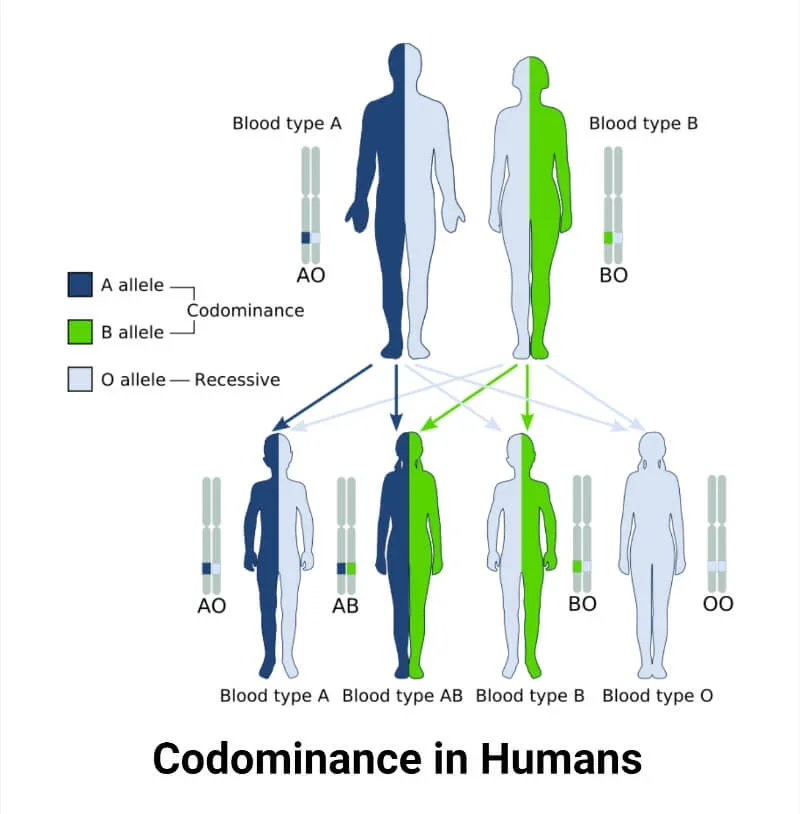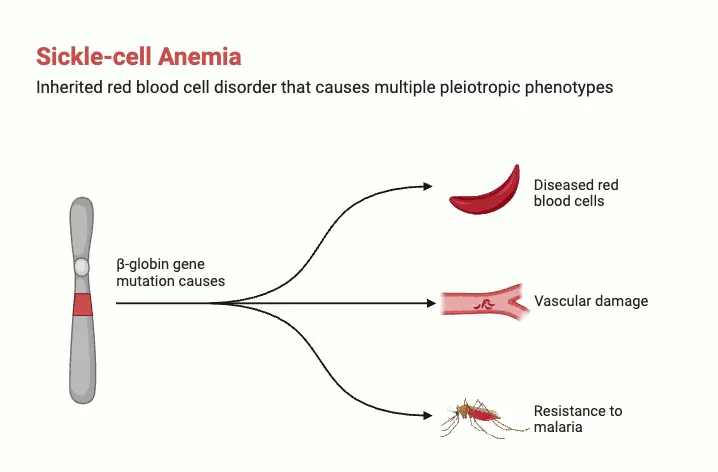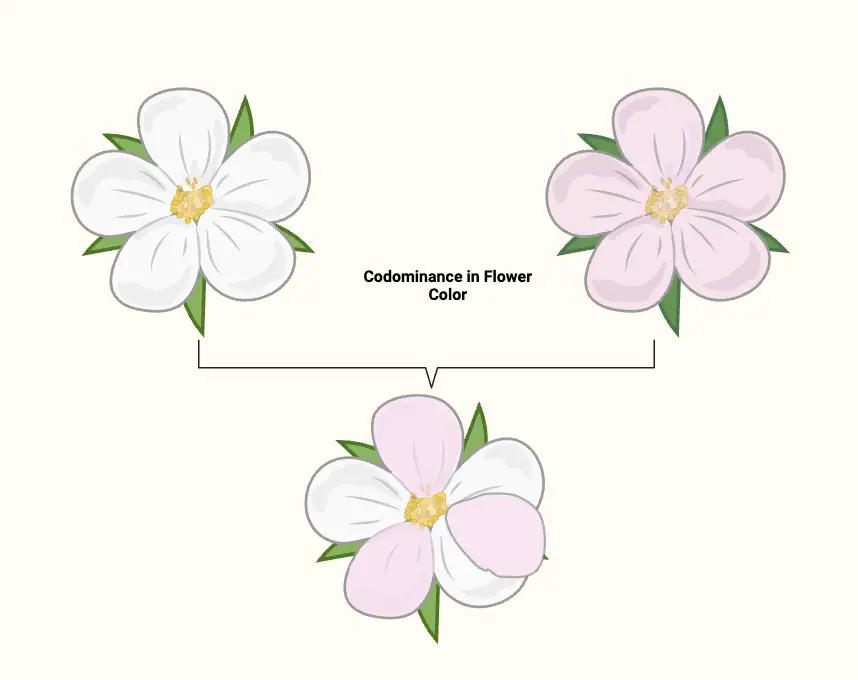What is Codominance?
- Codominance is a genetic phenomenon where two different alleles at a single locus are both fully expressed in a heterozygous individual, resulting in a phenotype that displays characteristics of both alleles. Unlike simple dominance, where one allele masks the effect of another, codominance allows both alleles to contribute equally to the organism’s phenotype.
- At the molecular level, codominance involves the production of distinct gene products from each allele. These products could be different transcripts, proteins, or metabolites produced by the alleles. For example, in the ABO blood group system, individuals with the AB genotype express both A and B antigens on their red blood cells. This expression results from the simultaneous activity of two different glycosyltransferases encoded by the A and B alleles, respectively. Therefore, both antigens are present, illustrating codominance.
- Another instance of codominance is observed in beta-thalassemia minor. In this condition, individuals with one normal allele and one mutant allele produce both normal and abnormal hemoglobin beta-chains. The presence of both types of chains in equal amounts is a direct result of codominance.
- Codominance is often contrasted with incomplete dominance, where the heterozygote displays an intermediate phenotype that is a blend of the two homozygous phenotypes. In contrast, codominance results in the coexistence of both traits rather than a blending effect.
- Thus, codominance highlights a unique way in which alleles interact to influence the phenotype, providing a clearer understanding of genetic inheritance beyond the traditional concepts of dominance and recessiveness.
Definition of Codominance
Codominance is a genetic scenario where two different alleles at a locus are both fully expressed in a heterozygote, resulting in a phenotype that displays traits of both alleles simultaneously.
What are the Symbolism for codominant alleles?
- Upper-Case Letters with Different Superscripts: In the notation of codominant alleles, each allele is represented by an upper-case letter, and distinct superscripts are used to differentiate between the alleles.
- Expression of Both Alleles: The use of distinct upper-case letters and superscripts signifies that both alleles are equally expressed in the phenotype of a heterozygote. This notation highlights the fact that neither allele is dominant over the other.
- Examples in Practice:
- ABO Blood Group System: For the ABO blood group locus, alleles are denoted as I^A and I^B. In individuals with genotype I^A I^B, both A and B antigens are expressed on red blood cells.
- Beta-Thalassemia Minor: In this condition, codominant alleles for beta-globin chains might be denoted as (β)beta^A and (β)beta^B, with each type of beta-globin chain being produced in roughly equal amounts.
- Indication of Codominance: The distinct superscripts in the symbolism clearly indicate that both alleles contribute equally to the organism’s phenotype, without masking each other.
- Clarification of Phenotypic Expression: Therefore, this notation system provides a clear and concise method for representing and understanding the expression patterns of codominant alleles in genetic studies.
Examples of Codominance
Codominance in Animals
- Shorthorn Cattle:
- Description: In Shorthorn cattle, codominance is illustrated by the coat color. Crossing a red-coated cattle (CRCR) with a white-coated cattle (CWCW) results in offspring with a roan coat (CRCW).
- Phenotype: The roan coat displays distinct red and white hairs without blending, demonstrating that both red and white alleles contribute equally to the coat color.
- Horses:
- Description: In horses, codominance is seen in the roan coat color. Different varieties include red roan, bay roan, and blue roan.
- Phenotype: Each type of roan exhibits a combination of colors in distinct regions, reflecting the equal expression of the roan gene’s different alleles.
Codominance in Humans

- M-N Blood Group System:
- Description: The M-N blood group system in humans shows codominance through the alleles LM and LN. These alleles encode different antigens on red blood cells.
- Genotypes and Phenotypes:
- LMLM: Blood group M, with only M antigens.
- LNLN: Blood group N, with only N antigens.
- LMLN: Blood group MN, with both M and N antigens.
- Agglutination Chart:
- LMLM: Reacts with Anti-M (+), does not react with Anti-N (–).
- LNLN: Does not react with Anti-M (–), reacts with Anti-N (+).
- LMLN: Reacts with both Anti-M (+) and Anti-N (+).
- ABO Blood Group System:
- Description: In the ABO blood group system, alleles A and B are codominant. Individuals with genotype AB express both A and B antigens.
- Genotypes and Phenotypes:
- AA or AO: Blood group A.
- BB or BO: Blood group B.
- AB: Blood group AB, showing traits of both A and B antigens.
- Sickle-Cell Anemia:
- Description: Sickle-cell anemia illustrates codominance at the hemoglobin level. The alleles HbA (hemoglobin A) and HbS (hemoglobin S) affect the shape and type of hemoglobin produced.
- Genotypes and Phenotypes:
- HbAHbA: Normal red blood cells, containing only hemoglobin A.
- HbSHbS: Sickle-shaped red blood cells, containing only hemoglobin S, leading to severe anemia.
- HbAHbS: Red blood cells that sickle under low oxygen but contain both hemoglobin A and S, reflecting codominance.

Codominance in Plants
- Rhododendrons:
- Description: In rhododendrons, codominance results in flowers displaying both red and white petals simultaneously.
- Phenotype: The presence of both red and white pigments in the petals demonstrates the simultaneous expression of both alleles for flower color.
- Camellias:
- Description: When a white Camellia is crossed with a red Camellia, the offspring produce flowers with both red and white petals.
- Phenotype: This results from the codominant expression of the red and white petal color genes, displaying both colors in the flowers.

Importance of Codominance
- Enhanced Genetic Diversity:
- Explanation: Codominance contributes to genetic diversity within populations by allowing multiple alleles to be expressed simultaneously. This diverse expression can increase the variability of traits within a population, which is crucial for adaptation and evolution.
- Impact: Increased genetic diversity provides a broader range of genetic options for natural selection to act upon, potentially enhancing the overall adaptability and survival of a species.
- Improved Individual Fitness:
- Explanation: In some cases, codominance can lead to improved fitness of individuals by allowing the simultaneous expression of advantageous traits from both alleles. For instance, in certain genetic conditions, the presence of codominant alleles can provide a functional advantage or reduce the severity of a disease.
- Impact: By expressing traits from both alleles, individuals may benefit from a combination of traits that contribute to better health or improved physiological functions.
- Differentiation of Heterozygotes and Homozygotes:
- Explanation: Codominant markers are valuable for distinguishing between heterozygous and homozygous genotypes. This is particularly important in genetic research and breeding programs where precise genotypic identification is required.
- Impact: The ability to differentiate between these genotypes aids in the accurate assessment of genetic variations and the prediction of inheritance patterns.
- Determination of Genotypes and Allele Frequencies:
- Explanation: Codominant markers facilitate the determination of genotypes and allele frequencies at specific genetic loci. This is achieved by directly observing the expression of different alleles.
- Impact: Understanding allele frequencies and genotypic distributions helps in population genetics studies, conservation efforts, and the management of genetic resources.
- Applications in Genetic Research and Medicine:
- Explanation: Codominance plays a crucial role in genetic research and medical diagnostics. For example, in human blood typing and various genetic disorders, codominance allows for the precise identification of genetic traits and disease predispositions.
- Impact: This precision improves diagnostic accuracy, helps in the development of targeted therapies, and enhances our understanding of genetic diseases and inheritance patterns.
Difference Between Codominance, Incomplete Dominance and Dominance
Difference Between Codominance, Incomplete Dominance, and Dominance
- Dominance:
- Definition: Dominance occurs when one allele completely masks the effect of another allele at the same locus. This means that in a heterozygote, the dominant allele’s trait is expressed while the recessive allele’s trait is suppressed.
- Example: In Mendel’s pea plant experiments, the allele for red flower color (R) is dominant over the allele for white flower color (r). Therefore, a heterozygous plant (Rr) will have red flowers because the red allele dominates over the white allele.
- Phenotype: The phenotype of the organism reflects only the dominant trait, overshadowing the recessive trait.
- Codominance:
- Definition: Codominance is a genetic scenario where both alleles at a locus are fully expressed simultaneously in a heterozygote. Neither allele is dominant or recessive; instead, both contribute equally to the phenotype.
- Example: In the ABO blood group system, alleles I^A and I^B are codominant. An individual with genotype I^A I^B will express both A and B antigens on the surface of red blood cells, resulting in blood group AB.
- Phenotype: The phenotype displays both traits from each allele distinctly, without blending. For instance, in a roan Shorthorn cattle, both red and white hairs are present.
- Incomplete Dominance:
- Definition: Incomplete dominance occurs when neither allele is completely dominant over the other. The resulting phenotype is a blend or intermediate expression of the two alleles.
- Example: In the case of flower color in certain plants, crossing a red-flowered plant with a white-flowered plant can result in offspring with pink flowers. The pink color is an intermediate expression of the red and white alleles.
- Phenotype: The phenotype is a mix of the two parental traits, creating a new, intermediate color or characteristic.
| Feature | Dominance | Codominance | Incomplete Dominance |
|---|---|---|---|
| Definition | One allele masks the effect of another allele. | Both alleles are fully expressed simultaneously. | Neither allele is completely dominant; both contribute to the phenotype. |
| Expression of Alleles | Only the dominant allele’s trait is expressed. | Both alleles’ traits are expressed equally and visibly. | The traits blend to form a new, intermediate phenotype. |
| Phenotype | Phenotype reflects only the dominant trait. | Phenotype shows both traits distinctly. | Phenotype is a mix or intermediate between the two traits. |
| Example | Red flower color (R) dominates over white (r) in pea plants. | ABO blood group system: I^A I^B shows both A and B antigens. | Pink flower color from red and white flower cross. |
| Result in Heterozygote | Dominant trait is visible; recessive trait is not expressed. | Both traits are visible simultaneously. | An intermediate trait is visible. |
FAQ
What is codominance?
Codominance is a genetic phenomenon where two different alleles for a gene are expressed simultaneously, resulting in a phenotype that displays characteristics of both alleles.
How is codominance different from incomplete dominance?
In codominance, both alleles are fully expressed, leading to a phenotype that shows both traits simultaneously. In incomplete dominance, neither allele is fully dominant, resulting in a blended phenotype.
Can you give an example of codominance in humans?
Yes, the M-N blood group system in humans is an example of codominance. Individuals with the genotype LMLN have both M and N antigens on their red blood cells.
Are codominance and co-dominance the same?
Yes, both terms refer to the same genetic phenomenon. The hyphenated version is just a variation in spelling.
How does codominance affect phenotype?
In codominance, the phenotype displays characteristics of both alleles. For instance, if a flower has alleles for both red and white colors and exhibits codominance, the flower will have both red and white petals.
Is the ABO blood group system an example of codominance?
Yes, the ABO blood group system in humans is an example of codominance. Individuals with the genotype AB have both A and B antigens on their red blood cells.
Can codominance be observed in plants?
Absolutely! An example is the crossing of a white-colored Camellia with a red-colored Camellia, which produces flowers with both red and white petals due to codominance.
Why doesn’t codominance result in a blended trait like incomplete dominance?
In codominance, both alleles are fully and separately expressed without blending. Each allele retains its distinct characteristic in the phenotype.
How can codominance be identified in genetic crosses?
Codominance can be identified when offspring display both parental traits simultaneously without blending. For instance, in a genetic cross involving flower color, if the offspring produce flowers with both colors present, it indicates codominance.
Is codominance common in nature?
Codominance is one of several genetic inheritance patterns observed in nature. While it might not be as common as complete dominance, it is still a significant and naturally occurring phenomenon in both plants and animals.
- http://www.a-levelnotes.co.uk/biology-ocr-a2-notes-genetics-evolution-and-ecosystem-patterns-of-inheritance.html
- Xia, X. (2013). Codominance. Brenner’s Encyclopedia of Genetics, 63–64. doi:10.1016/b978-0-12-374984-0.00278-3
- https://www.biologyonline.com/dictionary/codominance
- http://dambe.bio.uottawa.ca/publications/2013EncyclGenetCodominance.pdf
- https://www.scribd.com/document/427637784/Definition-of-Codominance-docx
- https://ugcmoocs.inflibnet.ac.in/assets/uploads/1/223/6887/et/4200319060603032424.pdf
- https://www.vedantu.com/biology/codominance
- https://biologydictionary.net/codominance/
- Text Highlighting: Select any text in the post content to highlight it
- Text Annotation: Select text and add comments with annotations
- Comment Management: Edit or delete your own comments
- Highlight Management: Remove your own highlights
How to use: Simply select any text in the post content above, and you'll see annotation options. Login here or create an account to get started.